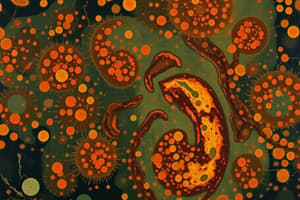Podcast
Questions and Answers
What is a characteristic of non-competitive antagonists?
What is a characteristic of non-competitive antagonists?
- They decrease the maximum response (E-max). (correct)
- They cause a rightward parallel shift in the dose-response curve.
- They increase potency of the agonist.
- They can be displaced by agonists.
Which of the following describes an irreversible non-competitive antagonist?
Which of the following describes an irreversible non-competitive antagonist?
- The blockade can be reversed by increasing agonist concentration.
- Binds covalently to the receptor. (correct)
- Binds reversibly to the receptor.
- Ends after the metabolism of the blocker.
What effect does chronic use of agonists have on receptors?
What effect does chronic use of agonists have on receptors?
- Increased sensitivity of receptors.
- No effect on receptor numbers or sensitivity.
- Up regulation of receptor numbers.
- Down regulation of receptor numbers. (correct)
Which type of receptor is activated by lipid-soluble ligands?
Which type of receptor is activated by lipid-soluble ligands?
What happens when a ligand binds to a ligand-gated ion channel receptor?
What happens when a ligand binds to a ligand-gated ion channel receptor?
What is the primary factor influencing simple diffusion for drug absorption?
What is the primary factor influencing simple diffusion for drug absorption?
Which statement about ionization and drug absorption is correct?
Which statement about ionization and drug absorption is correct?
What is the role of the pKa in drug ionization?
What is the role of the pKa in drug ionization?
In facilitated diffusion, which of the following statements is true?
In facilitated diffusion, which of the following statements is true?
What distinguishes active transport from facilitated diffusion?
What distinguishes active transport from facilitated diffusion?
Study Notes
Non-Competitive Antagonism
- Antagonist does not get displaced by the agonist, leading to a non-surmountable effect.
- Non-parallel shift of the dose-response curve to the right, indicating decreased potency of the agonist.
- Maximum response (E-max) is also decreased, which means decreased efficacy.
Types of Non-Competitive Block
Reversible Non-Competitive Block
- Antagonist binds reversibly to the receptor.
- Block is terminated by metabolism of the antagonist.
- Generally has a short duration of action.
- Examples include nicotine and succinylcholine.
Irreversible Non-Competitive block
- Antagonist binds covalently to the receptor.
- Block is terminated by resynthesis of new receptors.
- Generally has a long duration of action.
- Examples include phenoxybenzamine and organophosphorus compounds.
Chronic Drug Use and Receptor Regulation
- Long-term agonist use leads to downregulation of receptors, with a decrease in both the number and sensitivity of receptors.
- Long-term use of antagonists or drugs that inhibit neurotransmitter release leads to upregulation of receptors, with an increase in the number and sensitivity of receptors.
Types of Receptors and Signal Transduction Mechanisms
- Receptors have two main functions: ligand binding and generating an effector response by interacting with signaling systems.
- There are four main types of receptors: ligand-gated ion channels, G protein-coupled receptors, enzyme-linked receptors, and intracellular receptors.
Ligand-Gated Ion Channels
- Membrane receptors located on the gate of ionic channels.
- Binding of the ligand to the receptor causes conformational change in the receptor and changes cell membrane permeability to ions.
- Examples include acetylcholine receptors, which lead to increased sodium influx and depolarization, and GABA receptors, which lead to increased chloride influx and hyperpolarization.
- The time between ligand binding and cellular response is in the milliseconds range.
G Protein-Coupled Receptors (GPCRs)
- Ligand binds to a domain of a transmembrane receptor, which is coupled to a G protein.
Enzyme-Linked Receptors
- Ligand binds to the extracellular domain of a receptor that activates a kinase enzyme.
Intracellular Receptors
- Lipid-soluble ligands diffuse across the membrane to interact with its intracellular receptor.
Drug Absorption
- The chief process in drug absorption and distribution is simple diffusion.
- Factors affecting simple diffusion:
- Concentration gradient: Drugs move from high concentration to low concentration.
- Molecular size: Smaller molecules are absorbed better.
- Lipid solubility and lipid/water partition coefficient: Highly lipid-soluble drugs are absorbed better.
- Degree of ionization:
- Highly ionized drugs are less lipid-soluble, so less absorbed.
- Degree of ionization depends on the pKa of the drug and the pH of the medium.
- No energy or carriers are required for simple diffusion.
pKa and pH
- pKa is the ionization constant of a drug.
- It represents the pH at which 50% of the drug is ionized and 50% is non-ionized.
- Weak acids are better absorbed in acidic media, where they are less ionized and more lipid-soluble.
- Weak bases are better absorbed in alkaline media, where they are less ionized and more lipid soluble.
Henderson-Hasselbalch Equation
- Determines the degree of ionization.
- Weak acids: pKa = pH + log (unionized/ionized)
- Weak bases: pKa = pH + log (ionized/unionized)
Drug Absorption Examples
- Acidic drugs, like aspirin, are unionized in the acidic stomach and are better absorbed there.
- Weak base drugs, like amphetamine, are better absorbed from the intestine.
Carrier-Mediated Transport
- Drugs are transferred across cell membranes with the help of carriers.
- Two types: facilitated diffusion and active transport.
Facilitated Diffusion
- Drugs are transferred across cell membranes along their concentration gradient.
- Carriers are needed for large or lipid-insoluble substances.
- No energy is required.
- Example: glucose uptake by cells.
Active Transport
- Drugs are transferred across cell membranes against their concentration gradient.
- Energy and carriers are required.
- Example: active transport of drugs from the gut to the blood.
Factors Affecting Absorption
- State of the absorbing surface: Gastritis or malabsorption syndrome can decrease oral absorption.
- Motility of the gut and rate of dissolution: Prokinetic drugs, like metoclopramide, increase gut motility, leading to faster gastric emptying.
- This increases absorption of rapidly disintegrating drugs and decreases absorption of slowly disintegrating drugs.
- pH within the gut: Weak acids are better absorbed in acidic media and weak bases are better absorbed in alkaline media.
- Specific factors: Intrinsic factor from the stomach is essential for vitamin B12 absorption.
- Gut contents:
- Food can dilute drugs and compete for absorption.
- Some drugs, like aspirin and iron, may be better absorbed with food because it helps with irritation.
- P-glycoprotein:
- A transporter protein responsible for pumping drugs back into the gut lumen.
- Inhibits drug absorption.
- Grapefruit juice inhibits P-glycoprotein, which can increase drug absorption.
- First-pass effect:
- Metabolism of a drug in the gut wall or liver before reaching systemic circulation.
- Can significantly reduce drug bioavailability.
- Avoidance methods:
- Changing the route of administration: Nitroglycerine is administered sublingually to bypass first-pass metabolism.
- Increasing the oral dose: To compensate for the drug lost to metabolism.
Bioavailability
- The fraction of an unchanged drug reaching systemic circulation after any route of administration.
- 100% after intravenous (IV) administration.
- Variable after oral administration.
- Oral bioavailability is calculated as (AUC oral / AUC IV) x 100.
Factors Affecting Oral Bioavailability
- Amount of drug absorbed: Factors affecting gastrointestinal (GIT) absorption.
- First-pass metabolism: Metabolism of the drug before it reaches systemic circulation.
Efficacy and Potency
- Efficacy: The ability of a drug-receptor complex to evoke a response.
- Potency: The dose of the drug required to produce a specific effect.
Dose-Response Curve
- The relationship between drug concentration and response.
- Usually hyperbolic but becomes sigmoid when log dose is plotted against the response.
Types of Useful Responses
- Minimal effect (Emin): The lowest dose at which a drug elicits measurable effects.
- Maximal effect (Emax): The highest achievable effect with increasing drug doses.
- Submaximal effects: Effects observed at doses lower than the Emax.
Maintenance Dose
- The dose needed to maintain a steady-state concentration (Css) of the drug in the body.
- Calculated as: (clearance x Css x dose interval)
- The smaller the dose interval, the smaller the maintenance dose.
Infusion Rate
- The rate at which a drug is infused into a patient.
- Can be calculated as: (clearance x Css).
Pharmacodynamics
- The study of how drugs interact with the body.
Possible Mechanisms of Drug Action
- Physical:
- Adsorption, for example kaolin in diarrhea.
- Osmotic, for example MgSO4 as a saline purgative and mannitol as an osmotic diuretic.
- Chemical:
- Neutralization: NaHCO3 (antacid) + HCl (gastric acid) in treatment of hyperacidity.
- Chelation: Organic compound + heavy metal → Non-toxic, easily excreted complex. Example: Desferrioxamine for ferric iron (Fe+3).
- Interfere with cell division: Anti-cancer drugs.
- Interfere with metabolic pathways: Sulfonamides compete with PABA in bacteria, inhibiting folic acid synthesis.
- Inhibition of enzymes: Physostigmine (inhibits cholinesterase), aminophylline (inhibits phosphodiesterase), and aspirin (inhibits cyclooxygenase).
- Action on ionic channels in the cell membrane: Local anesthetics, like procaine, block sodium channels and stabilize membranes.
- Action on specific receptors: The most common mechanism of drug action.
Receptor Definition
- A chemo-sensitive and chemo-selective protein macromolecule that interacts specifically with a ligand (drug, transmitter, or hormone) to produce a biological response.
- Can be membrane-bound, cytoplasmic, or nuclear.
Drug-Receptor Interaction
- Drug + Receptor ⇌ Drug/Receptor Complex → Response
- Ka = Association constant (affinity of the drug for the receptor)
- Kd = Dissociation constant (affinity of the drug for the receptor)
Affinity
- The ability of a drug to bind to its receptor.
Studying That Suits You
Use AI to generate personalized quizzes and flashcards to suit your learning preferences.
Related Documents
Description
Test your knowledge on non-competitive antagonism in pharmacology. This quiz covers both reversible and irreversible non-competitive blocks, their characteristics, and effects on drug efficacy. Understand how chronic drug use influences receptor regulation.




